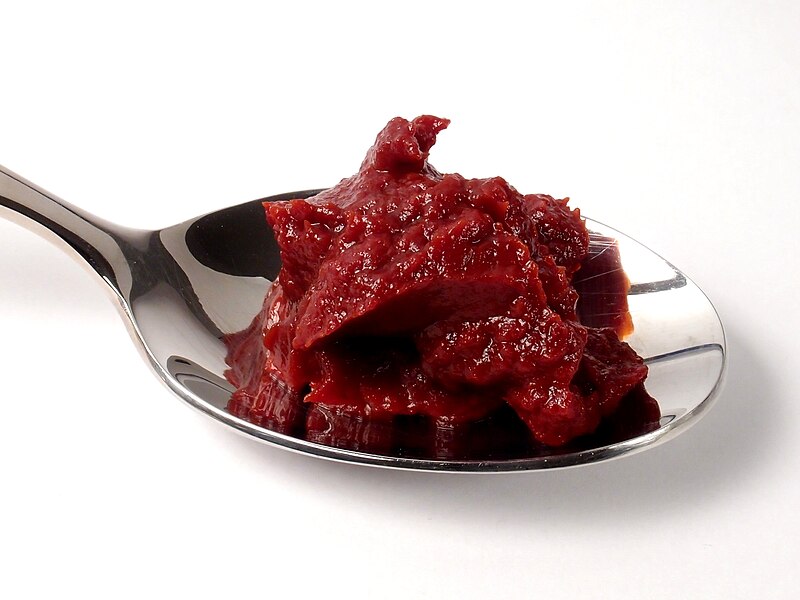One thing about tomato paste is that it needs a lot of tomatoes to make. Tomatoes are about 95% water and 5% solids/sugar. The next time you reach for that can of tomato puree, check the concentrate percentage. Probably, the label will read “dual concentrate” and the merchandise will contain about 28% solid materials (also called Brix). So if you’re making paste, you shall need 5.6kgs of tomatoes with a 5% sugars content to make 1kg of tomato paste at 28% Brix.

There are two types of tomato paste - Hot Break and Cold Break - and they’re used to get different end products. To create Hot Break (HB) paste, the new tomatoes must be warmed soon after chopping to a high temperature (ranging from 85 to 100°C). Cold Break (CB) paste requires the fresh, cut tomatoes to be heated at a lesser temperature (which ranges from 65 to 75°C). HB paste is usually used for ketchup and various types of tomato sauce needing a 28-30° Brix, while CB paste is used for triple concentrate paste at 36-38° Brix.
Tomato paste processing need a continual way to obtain fresh tomatoes, which is quite crucial for the tomato control series to operate at maximum capacity constantly. If capacity drops below a certain threshold, or worse even, if paste can’t be made at all in a day, then the process needs to halt while all the equipment is cleaned properly.
Here are the steps required for tomato paste processing.
- Getting: Fresh tomatoes in the trucks are taken to the offloading area. An operator, utilizing a special tube, sends a huge quantity of water into the pickup truck, so that the tomatoes can flow right out of the opening at the end of the trailer. Using water allows the tomatoes to be moved without damage.

-
Sorting: Water is constantly pumped to transport the tomatoes into roller elevator, rinse them, and then send the tomatoes to the sorting station. In the sorting station, materials besides the tomatoes are removed as well as discoloured, green and damaged tomatoes. This is usually done by hand, but some facilities possess the equipment for automated sorting.
-
Chopping: The ideal tomatoes are pumped to the chopper area where they will be chopped.
-
Cool or Hot Break: The pulp is pre-heated to 65-75°C for CH processing or to 85-95°C for HB processing.
-
Juice Removal: The pulp (comprising fibre, juice, pores and skin and seeds) is then pumped via a removal unit made up of a pulper and a refiner; these are large sieves. Depending on the customer requirements, these sieves allow the pulp to end up as either coarser or smoother. Typically, 95% of the pulp pass through both sieves. The remaining 5%, made up of fibre, seeds and skin, is considered waste and is transported from the station to be sold as feed for livestock.
-
Holding tank: The enhanced juice is collected in a sizable holding tank, which feeds the evaporator constantly.
-
Evaporation: Evaporation is the most energy-intensive step of the tomato paste process. It is here water is extracted, this is where the water is extracted, and the juice that is still only 5% solid becomes 28% to 36% concentrated tomato paste. The evaporator regulates juice intake and finished concentrate output automatically; the operator only needs to set the Brix value on the control panel for the level of concentration needed.
As the juice inside the evaporator goes by through different stages, its concentration steadily increases until the required density is obtained in the ultimate “finisher” stage. The complete concentrate/evaporation process occurs under vacuum conditions, at temperatures below 100°C.
- Aseptic Filling: Most facilities package the completed product using aseptic bags, so the product in the evaporator never makes connection with air before the customer is reached. The concentrate is delivered from the evaporator right to an aseptic container - it is then pumped through the aseptic sterilizer-cooler (also known as a flash cooler) to the aseptic filler, where it is loaded into large, pre-sterilized aseptic hand bags. Once packed, the concentrate can be kept up to two years.

Some facilities choose to bundle their finished product under non-aseptic conditions. This paste must proceed through yet another step after product packaging - it is warmed to pasteurize the paste, and then held under check for two weeks before it goes to the customer.
###How Expensive is Tomato Paste Processing?
Tomato paste processing is a capital and energy intensive venture. So when next you have to use a bottle of ketchup or some cooking paste, you’ll know how it came to be.
Please use the Crop Calendar to learn more information about tomatoes. You can also view more topics at the World Bank. Also Follow us on Instagram